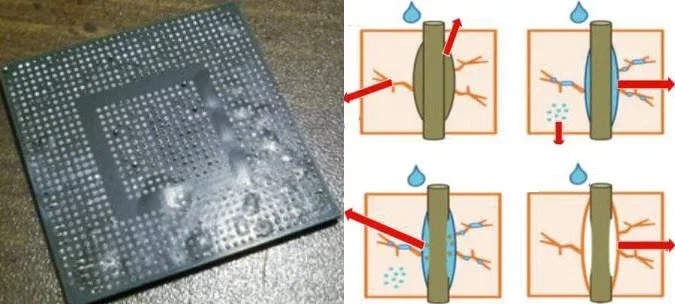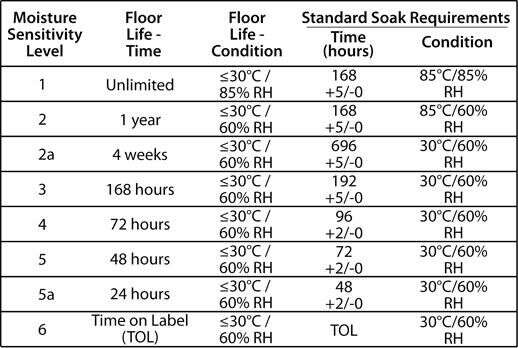The popcorn effect is possibly the biggest disappointment of plastic-exemplified microelectronic devices during PCB assembly. What is the popcorn effect in the assembly process and its damages, how to avoid it, and what is the moisture-sensitive level? You may have so many questions about the popcorn effect in your mind. This blog provides all you want to know about popcorning.
What is the Popcorn Effect During the PCB Assembly Process

In short, the popcorn effect is when the IC or BGA blows up or even breaks because the dampness inside the bundle grows in the reflow interaction. To be more detailed, we need to mention plastic-exemplified microelectronic devices used in airtight parts. During the PCB assembly process, dampness in a plastic bundle can disintegrate under high temperatures and apply weight to the bundle. This pressure makes the bundle break and causes delamination between the shaping compound and the lead casing or bites the dust.
Patching the ball inside with lead measure and outside with sans lead may bring about disappointment. It is provoked by the softening mark of lead and without lead material, and this is distinctive in a similar ball grid array (BGA) packaging chip. In most serious cases, the packaging surrenders and the pressure may bring about outer bundle breaks. Furthermore, the BGA packaging chip has a void in the joint interface, where dust appends and this leads to a short out between certain pins.
Question: how do we detect the popcorn effect?
The extension can result in the bite of the dust or harm to the substrate or wire securities. The harm is regularly undetectable and requires X-beam hardware to lead an appropriate examination.
What Causes Popcorn Effect in PCB Assembly
Popcorning is a dampness-initiated issue of delamination and breaking. The popcorn effect is caused when dampness inside a plastic bundle IC goes to steam and extends quickly during infrared and fume stage reflow bind measure. Under specific conditions, the power from the growing dampness can cause stresses inside the bundle.
The main causes of the popcorn effect are:
- Improper fabrication of the component
- Improper design of the component
- Improper packaging of the component during shipping
- Improper storage of components at incoming and on the manufacturing, floor resulting in excessive absorbed moisture
At the point when the antistatic pack is opened and the ICs are presented with surrounding conditions, the dampness noticeable all around is caught inside the device. This implies that during the PCB gathering measure (for example reflow) this dampness extends and can harm the device.
How to Avoid Popcorn Effect in PCB Assembly
To keep harm from the popcorn effect, plastic-epitomized microelectronic devices should be prepared before gathering to drive out the dampness.
To maintain a strategic distance from the popcorn effect, basically prepare the devices and seal them in an airtight fixed antistatic pack. Utilize a dampness sign card to guarantee your devices are not transforming into popcorn. It is acceptable practice to investigate the humidity indicator card quickly after opening the parcel and supplanting it with a new card with each utilization.

If the devices were presented to dampness, re-bake them and amass the devices inside the permitted openness time. The baking is driving all the dampness out of the device.

Coming up next are significant focuses to focus on with a moisture control program:
- Keep a definite record of openness times each time the devices are utilized, and bake if the floor life has been surpassed. Baking resets the clock.
- Keep up encompassing industrial facility conditions to lessen moisture penetration during dealing with and fastening floor life estimations.
- Baking occasions for various MSL devices, bundle thicknesses, and baking conditions are changed from one case to another.
- Higher-level moisture-sensitive level devices must be baked before every use within the specified floor life.
- Care should be taken to avoid baking for too long or at higher than necessary temperatures to prevent oxidation and the formation of intermetallic compounds in the device.
- The relevant baking tray for the baking temperature should be used to prevent the formation of gases.
- The entire board should be baked if the device requires reworking to prevent damage.
The reflow profile should be coordinated with the prerequisites of the patch glue, just as the warm limits of the PCB get together. Fundamentally, exact profiling is accomplished and a precise information recording framework is used Lead-free bind glues don't change the essential standards of weld reflow. They do fundamentally lessen the size of the warm interaction window, and thus make reflow a more basic advance in the sequential construction system, influencing all out-item quality yield.
Tests to Check for Popcorn EffectOne of the significant devices presently used to non-dangerously review the disappointment include came about because of the "popcorn effect" of plastic-epitomized microelectronic devices was Scanning Acoustic Microscopy (SAM). Applications included non-destructive identification of delamination between lead outline, pass on the face, paddle, heat sink, breaks, and plastic encapsulant. Also, another ruinous method was cross-segment examination which could approve the aftereffect of SAM assessment and more outwardly present the disappointing appearance. For case one, by C-mode Scanning Acoustic Microscopy (C-SAM) investigation delamination was seen at the interface of the PCB and trim compound at some external bonds. Also, PCB breaks and wire bond breaks could be seen by cross-segment investigation. For case two, the C-SAM investigation can detect delamination at the interface that can bite the dust. What's more, die breaks and both wedge bond and ball bond breaks could be seen by cross-area examination.
Moisture-Sensitive Devices
Moisture-sensitive devices (MSDs) are electronic parts epitomized with plastic mixtures and other natural materials. Moisture from climatic mugginess enters penetrable packaging materials by dissemination and gathers at the interfaces of divergent materials.
MT LEDs are classed as moisture-sensitive devices (MSD) as per moisture affectability norms. BGA and chip-scale packages are also moisture-sensitive. The popcorn effect may occur in these MSDs. To amplify the creation, yield, and lifetime of the devices, additional precautionary measures should be taken during stockpiling, dealing with, and gathering.
To classify the MSDs’ moisture sensitivity levels, the IPC/JEDEC J-STD-020B and IPC/JEDEC J-STD-033B are the standards to use.
High-Quality PCB Assembly - Choose PCBONLINE
Now you know about the popcorn effect, and finding a reliable PCB assembler is on top priority. PCBONLINE, a one-stop middle and high-end PCB manufacturer, is your trusted supplier for the assembly. We have one component warehouse next to our assembly factory, and the moisture sensitivity level test and re-baking to MSDs are operated before the assembly.
Complete moisture sensitivity level test and functional test on components before assembly
High-quality PCB assembly free from any issues such as the popcorn effect
Traceable PCB manufacturing, assembly, and component sourcing
Free functional test after the assembly and discount for bulk orders
You can get an insight into how we assemble PCBs in the below video. Register from PCBONLINE and earn $100 off coupons. Get an online quote now!





